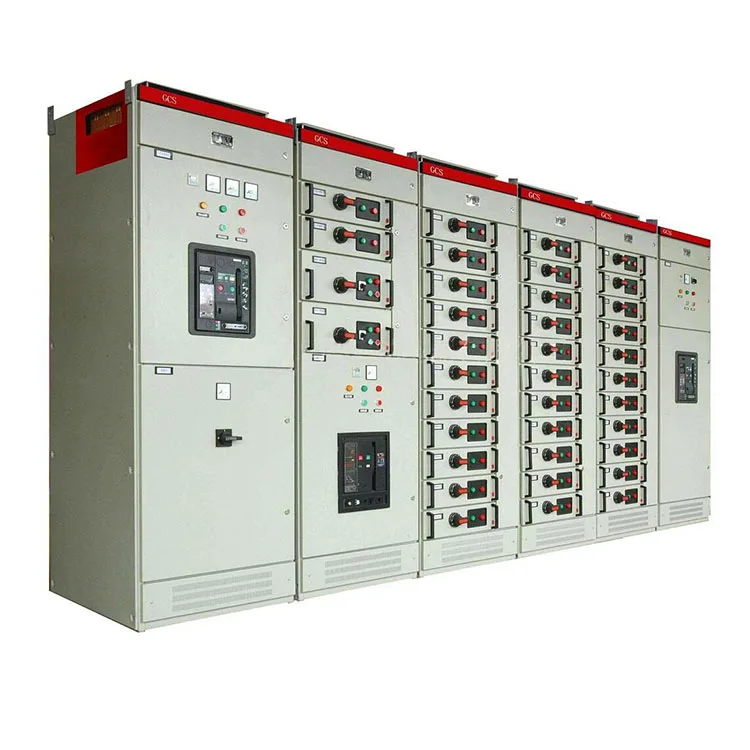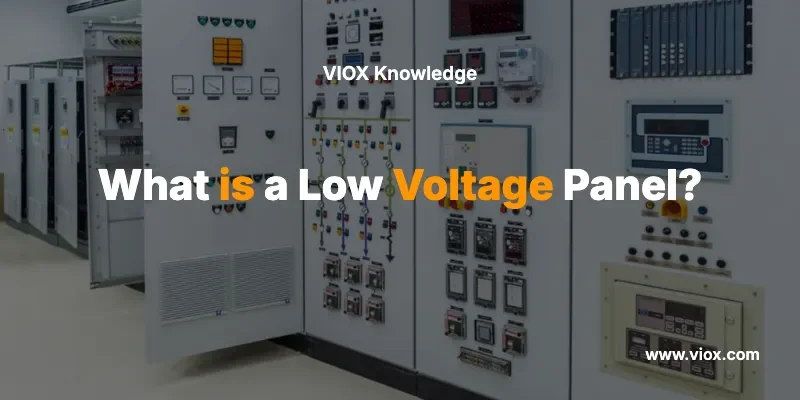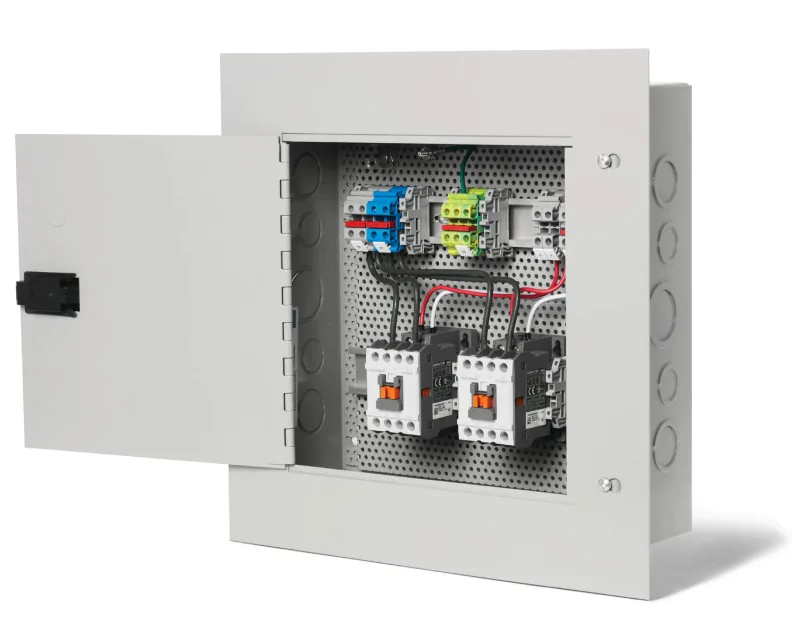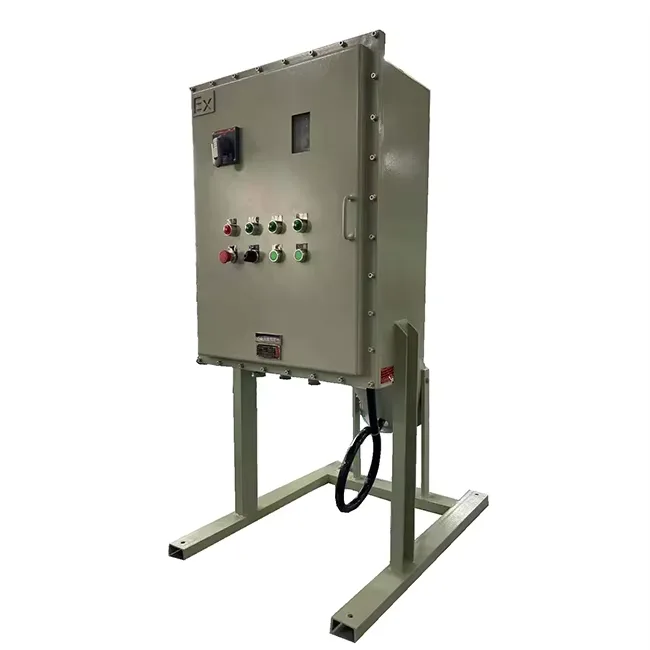Un pannello a bassa tensione Un quadro elettrico di distribuzione è un quadro elettrico che gestisce e distribuisce energia elettrica a tensioni tipicamente inferiori a 1.000 volt CA o 1.500 volt CC. Questi quadri fungono da punti di controllo centrali che distribuiscono in modo sicuro l'elettricità dalle principali fonti di alimentazione a vari circuiti, carichi e apparecchiature in strutture residenziali, commerciali e industriali.
I quadri a bassa tensione sono componenti di sicurezza essenziali che proteggono gli impianti elettrici tramite interruttori automatici, fusibili e dispositivi di monitoraggio, garantendo al contempo una distribuzione organizzata dell'energia all'illuminazione, alle prese, ai sistemi HVAC e ad altre apparecchiature elettriche.
Cosa differenzia i pannelli a bassa tensione da quelli ad alta tensione?

Per la sicurezza elettrica e la corretta progettazione del sistema è fondamentale comprendere la differenza tra quadri elettrici a bassa e ad alta tensione.
Confronto tra pannelli a bassa tensione e ad alta tensione
| Funzione | Pannelli a bassa tensione | Pannelli ad alta tensione |
|---|---|---|
| Gamma di tensione | Inferiore a 1.000 V CA / 1.500 V CC | Oltre 1.000 V CA / 1.500 V CC |
| Applicazioni Tipiche | Sistemi di controllo residenziali, piccole attività commerciali | Impianti industriali, sottostazioni di servizio pubblico |
| Requisiti di sicurezza | Pratiche standard di sicurezza elettrica | Protocolli di sicurezza specializzati ad alta tensione |
| Complessità dell'installazione | Elettricisti moderati e qualificati | Sono richiesti tecnici altamente specializzati |
| Costo | Costi iniziali e di manutenzione inferiori | Costi iniziali e di manutenzione più elevati |
| Requisiti di spazio | Compatto, da parete o da pavimento | Ingombro maggiore, stanze specializzate |
| Rischio di arco elettrico | Livelli di energia più bassi | Livelli di energia più elevati, DPI specializzati richiesti |
Componenti chiave dei pannelli a bassa tensione
I quadri a bassa tensione contengono diversi componenti critici che lavorano insieme per garantire una distribuzione di energia sicura e affidabile:
Componenti essenziali del pannello
1. Interruttore principale o sezionatore principale
– Controlla l’alimentazione dell’intero pannello
– Fornisce la capacità di spegnimento di emergenza
– Dimensionato in base all'amperaggio totale del pannello
2. Ramo Interruttori automatici
– Proteggere i singoli circuiti da sovracorrente
– Disponibile in vari amperaggi valutazioni (15A, 20A, 30A, ecc.)
– Intervento automatico in caso di sovraccarico del circuito
3. Barre collettrici
– Conduttori in rame o alluminio che distribuiscono energia
– Il bus principale trasporta l’energia dall’ingresso del servizio
– I bus di diramazione distribuiscono l’energia ai singoli circuiti
4. Barre neutre e di terra
– Fornire un percorso di ritorno per la corrente elettrica
– Essenziale per la sicurezza e il corretto funzionamento del circuito
– Deve essere adeguatamente legato secondo i requisiti NEC
5. Contenitore del pannello
– Protegge i componenti interni dai fattori ambientali
– Fornisce una barriera di sicurezza contro il contatto elettrico
– Disponibile in varie classificazioni NEMA per diversi ambienti
🔧 Esperto Suggerimento: Verificare sempre che il pannello a bassa tensione soddisfi i requisiti appropriati NEMA classificazione per l'ambiente di installazione. I pannelli per interni in genere utilizzano la classificazione NEMA 1, mentre le installazioni esterne richiedono la classificazione NEMA 3R o superiore.
Tipi e classificazioni dei pannelli a bassa tensione
I quadri a bassa tensione sono disponibili in varie configurazioni progettate per applicazioni e requisiti di installazione specifici.
Tipi di pannelli per applicazione
| Tipo di pannello | Gamma di tensione | L'Uso Tipico | Caratteristiche principali |
|---|---|---|---|
| Centri di carico residenziali | 120/240V monofase | Case, piccoli appartamenti | 20-40 circuiti, interruttori a spina |
| Quadri elettrici commerciali | 120/208V o 277/480V trifase | Edifici per uffici, vendita al dettaglio | Circuiti 30-84, interruttori imbullonati |
| Pannelli di controllo industriali | 24 V-600 V CC/CA | Produzione, automazione | Configurazioni personalizzate, sistemi di monitoraggio |
| Centri di controllo motore (MCC) | 208V-600V trifase | motori industriali | Azionamenti a frequenza variabile, avviatori |
| Pannelli di distribuzione | 120V-600V | Grandi strutture | Amperaggio elevato, alimentatori multipli |
Classificazioni dei pannelli per costruzione
Pannelli montati in superficie
– Installato su superfici murali
– Accesso più facile per la manutenzione
– Comune nelle applicazioni commerciali
Pannelli a filo (incassati)
– Installato all’interno delle cavità dei muri
– Aspetto più pulito, risparmio di spazio
– Popolare nelle installazioni residenziali
Pannelli autoportanti
– Unità montate a pavimento
– Applicazioni ad alta capacità
– Uso industriale e commerciale su larga scala
Applicazioni e casi d'uso per pannelli a bassa tensione
I pannelli a bassa tensione trovano impiego in diverse applicazioni nei settori residenziale, commerciale e industriale.
Applicazioni residenziali
Funzioni primarie:
– Distribuire l’energia dal servizio di pubblica utilità ai circuiti domestici
– Proteggere i circuiti di illuminazione e di presa
– Controllare i principali elettrodomestici (scaldabagni, HVAC, ecc.)
- Fornire GFCI e AFCI protezione come richiesto dal codice
Dimensioni comuni dei pannelli residenziali:
– Servizio da 100 ampere: case più piccole, esigenze elettriche di base
– Servizio da 200 ampere: case moderne standard
– Servizio da 400 ampere: case grandi con sistemi elettrici estesi
Applicazioni commerciali
Edifici per uffici:
– Distribuzione di energia ai piani e agli spazi degli inquilini
– Sistemi di controllo dell’illuminazione
– Alimentazione delle apparecchiature HVAC
– Circuiti di illuminazione di emergenza
Strutture commerciali:
– Illuminazione del negozio e potenza del display
– Circuiti del sistema di punto vendita
– Alimentazione del sistema di sicurezza
– Circuiti delle apparecchiature di refrigerazione
Applicazioni industriali
Impianti di produzione:
– Controllo motore e distribuzione di potenza
– Potenza del sistema di controllo di processo
– Circuiti del sistema di sicurezza
– Strumentazione e apparecchiature di monitoraggio
Centri dati:
– Distribuzione dell’alimentazione del rack del server
– Integrazione del sistema UPS
– Potere di controllo ambientale
– Circuiti delle apparecchiature di rete
⚠️ Avviso Di Sicurezza: Tutte le installazioni di quadri a bassa tensione devono essere conformi a Codice elettrico nazionale (NEC) articolo 408 e le normative elettriche locali. Solo elettricisti qualificati e autorizzati possono eseguire installazioni o modifiche dei quadri elettrici.
Come selezionare il pannello a bassa tensione giusto
Per scegliere il pannello a bassa tensione più adatto è necessario valutare attentamente diversi fattori critici.
Lista di controllo dei criteri di selezione
1. Requisiti di carico elettrico
– Calcolare il carico totale collegato in ampere
– Considerare le future esigenze di espansione (aggiungere capacità 25-30%)
– Determinare i requisiti di tensione e fase
– Valutare le correnti di cortocircuito nominali
2. Condizioni ambientali
– Installazione interna vs. esterna
– Considerazioni su temperatura e umidità
– Requisiti per atmosfere corrosive
– Fattori sismici e di vibrazione
3. Requisiti di conformità al codice
– Articolo 408 del NEC (Quadri elettrici e quadri elettrici)
– Modifiche al codice elettrico locale
– Certificazione UL 67 (Quadri elettrici)
– NEMA conformità agli standard
4. Vincoli dello spazio fisico
– Spazio di installazione disponibile
– Autorizzazioni di lavoro richieste (NEC 110.26)
– Preferenze di configurazione del montaggio
– Futuri bisogni di accessibilità
Guida alle dimensioni dei pannelli
| Applicazione | Amperaggio consigliato | Numero tipico di circuiti |
|---|---|---|
| Piccola Residenza | 100-150A | 20-30 circuiti |
| Casa standard | 200A | 30-40 circuiti |
| Grande casa | 300-400A | 40-60 circuiti |
| Piccola attività commerciale | 225-400A | 30-50 circuiti |
| Grande commerciale | 600-1200A | 50-84 circuiti |
🔧 Esperto Suggerimento: Dimensionare sempre i pannelli per 80% in base alla loro capacità nominale per consentire una corretta dissipazione del calore e la conformità alle normative. Un pannello da 200 ampere non deve superare i 160 ampere di carico collegato.
Considerazioni sull'installazione e sulla sicurezza
L'installazione corretta dei quadri elettrici a bassa tensione è fondamentale per la sicurezza, la conformità alle normative e l'affidabilità di funzionamento.
Requisiti di preinstallazione
1. Progettazione e permessi
– Ottenere i permessi elettrici necessari
– Calcoli completi dei carichi e schemi dei pannelli
– Verificare i requisiti del servizio di pubblica utilità
– Pianificare le distanze di sicurezza necessarie per il lavoro
2. Preparazione del sito
– Garantire un adeguato supporto strutturale
– Verificare le condizioni ambientali
– Pianificare il percorso e l’accesso dei cavi
– Coordinarsi con altri sistemi edilizi
Requisiti di sicurezza dell'installazione
Requisiti di autorizzazione al lavoro (NEC 110.26):
– Davanti: Spazio di lavoro libero minimo di 3 piedi
– Larghezza: Larghezza del pannello o minimo 30 pollici, a seconda di quale sia maggiore
– Altezza: 6,5 piedi dal pavimento o dalla piattaforma
– Spazio dedicato: Area sopra il pannello al soffitto strutturale
Requisiti di messa a terra e collegamento:
– Installazione del ponticello di collegamento principale
– Collegamenti del conduttore di terra dell'apparecchiatura
– Separazione di neutro e terra (per i sottoquadri)
– Dimensionamento del conduttore dell’elettrodo di messa a terra
⚠️ Avvertenza critica di sicurezza: Non tentare mai di installare, modificare o effettuare la manutenzione di quadri elettrici a bassa tensione senza un'adeguata formazione e licenza elettrica. I lavori elettrici comportano gravi rischi di scosse elettriche, folgorazione, incendio e morte.
Manutenzione e risoluzione dei problemi
Una manutenzione regolare garantisce il funzionamento sicuro e affidabile dei quadri elettrici a bassa tensione, prolungando al contempo la durata delle apparecchiature.
Programma di manutenzione ordinaria
Ispezioni mensili:
– Ispezione visiva per segni di surriscaldamento
– Verificare la presenza di collegamenti allentati o componenti danneggiati
– Verificare la chiusura dello sportello del pannello e il funzionamento della serratura
– Documentare eventuali condizioni insolite
Manutenzione professionale annuale:
– Ispezione termografica delle connessioni
– Verifica della coppia di serraggio di tutti i collegamenti
– Test di resistenza di isolamento
– Aggiornamento della valutazione del rischio di arco elettrico
Problemi comuni e soluzioni
| Problema | Possibili Cause | Soluzioni professionali |
|---|---|---|
| Frequenti scatti dell'interruttore automatico | Circuiti sovraccarichi, apparecchiature difettose | Analisi del carico, riconfigurazione del circuito |
| Surriscaldamento del pannello | Collegamenti allentati, sovraccarico | Serraggio dei collegamenti, ridistribuzione del carico |
| Fluttuazioni di tensione | Problemi di utilità, collegamenti scadenti | Coordinamento delle utenze, riparazione degli allacciamenti |
| Corrosione/ossidazione | Esposizione ambientale | Sostituzione dei componenti, aggiornamento del contenitore |
🔧 Esperto Suggerimento: Pianificare ispezioni termografiche annuali per identificare i punti caldi prima che diventino pericolosi per la sicurezza. Collegamenti allentati possono creare pericolose condizioni di arco elettrico.
In Conformità a norme e Standard
I quadri elettrici a bassa tensione devono rispettare numerosi codici e standard per garantire la sicurezza e il corretto funzionamento.
Requisiti del codice chiave
Articoli del Codice elettrico nazionale (NEC):
– Articolo 408: Quadri elettrici e quadri elettrici
– Articolo 110: Requisiti per gli impianti elettrici
– Articolo 240: Protezione da sovracorrente
– Articolo 250: Messa a terra e collegamento
Standard di settore:
– UL 67: Quadri elettrici Standard
– UL 891: Quadri elettrici Standard
– NEMA PB 1: Norme dei quadri elettrici
– Standard IEEE: Requisiti di installazione e test
Requisiti di certificazione
Certificazioni del pannello:
– Componenti e assiemi certificati UL
– Certificazione CSA per installazioni canadesi
– Approvazione NRTL (laboratorio di prova riconosciuto a livello nazionale)
– Approvazione dell’autorità locale competente (AHJ)
Domande Frequenti
Qual è la differenza tra un quadro elettrico e un quadro di distribuzione?
I quadri elettrici sono in genere classificati per 1.200 ampere o meno e utilizzano interruttori automatici a innesto o a bullone. I quadri elettrici sono classificati per correnti superiori a 1.200 ampere e utilizzano interruttori e interruttori automatici fissi montati singolarmente in un assemblaggio personalizzato.
Con quale frequenza devono essere ispezionati i quadri elettrici a bassa tensione?
Le ispezioni visive dovrebbero essere effettuate mensilmente, mentre le ispezioni professionali complete dovrebbero essere effettuate annualmente. I pannelli industriali ad alto utilizzo potrebbero richiedere una manutenzione più frequente ogni 6 mesi.
Posso aggiungere circuiti a un quadro a bassa tensione esistente?
Sì, se il pannello ha spazio e capacità disponibili. Tuttavia, questo lavoro deve essere eseguito da un elettricista qualificato e in genere richiede un permesso e un'ispezione elettrica.
Quali sono le cause del guasto di un pannello a bassa tensione?
Tra le cause più comuni rientrano collegamenti allentati che creano accumulo di calore, condizioni di sovracorrente, fattori ambientali come umidità o corrosione e degradazione dei componenti dovuta all'età.
Come faccio a sapere se il mio pannello a bassa tensione ha bisogno di essere sostituito?
Tra i segnali rientrano frequenti scatti dell'interruttore, corrosione o danni visibili, pannelli vecchi di oltre 25-30 anni, capacità insufficiente per i carichi di corrente o pannelli che non rispettano gli attuali codici di sicurezza.
Qual è la durata di vita tipica di un pannello a bassa tensione?
I pannelli ben manutenuti durano in genere dai 25 ai 40 anni. Tuttavia, i pannelli installati in ambienti difficili o sottoposti a un uso intenso potrebbero richiedere una sostituzione più rapida.
I quadri elettrici a bassa tensione richiedono utensili speciali per la manutenzione?
Sì, per una corretta manutenzione sono necessari termometri a infrarossi, chiavi dinamometriche, misuratori di isolamento e adeguati dispositivi di protezione individuale (DPI) per i lavori elettrici.
Le condizioni meteorologiche possono influire sulle prestazioni dei pannelli a bassa tensione?
Sì, temperature estreme, umidità e condensa possono influire sulle prestazioni del pannello. I pannelli per esterni richiedono le opportune classificazioni NEMA e potrebbero richiedere una protezione ambientale aggiuntiva.
Guida Di Riferimento Rapido
Lista di controllo per la selezione del pannello
- Calcolare i requisiti di carico elettrico totale
- Determinare le esigenze di tensione e fase
- Verificare lo spazio di installazione disponibile
- Controllare le condizioni ambientali
- Confermare i requisiti di conformità del codice
- Pianificare le future esigenze di espansione
- Ottenere i permessi e le approvazioni necessari
Promemoria di sicurezza
- Spegnere sempre l'alimentazione prima di lavorare sul pannello
- Utilizzare DPI adeguati per i lavori elettrici
- Mantenere le distanze di sicurezza richieste
- Provare i circuiti prima di iniziare il lavoro
- Seguire le procedure di blocco/etichettatura
- Consentire l'esecuzione dei lavori solo a elettricisti qualificati
Procedure di emergenza
- Emergenza elettrica: Spegnere immediatamente l'interruttore principale
- Fuoco: Utilizzare solo estintori di classe C
- Scossa elettrica: Chiamare il 911, non toccare la vittima finché non viene tolta la corrente
- Arco elettrico: Evacuare la zona, chiamare i servizi di emergenza
Correlati
Cosa causa l'incendio dei pannelli solari? Una guida completa alla sicurezza
Pannelli di controllo elettrici




